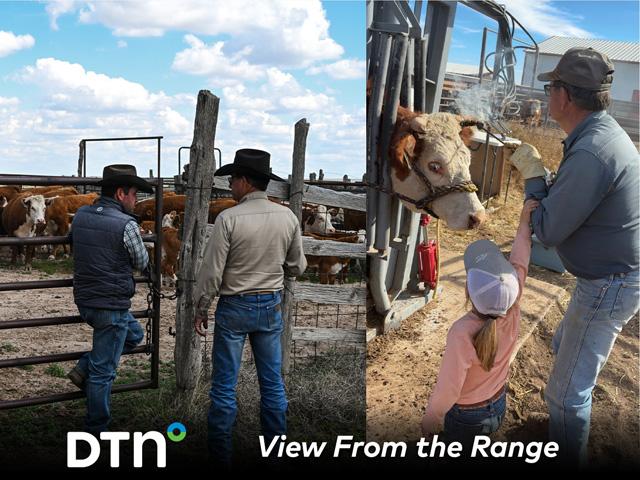Break Even on Replacement Heifers
UNL Extension Research Shows Replacement Heifer Breakeven Prices
OMAHA (DTN) -- The ongoing drought on the High Plains the last several growing seasons led cow-calf producers to cut back on cow numbers because of a lack of grass and hay. If the snow this winter is an indication that moisture is set to return to the region, many producers will be in the market for replacement heifers to rebuild their smaller herds.
At what level can an operation pay for these heifers and remain profitable depends on many different cost factors. Producers need to work through the math before they purchase replacement heifers, according to experts.
HEIFER BREAKEVEN
In a recent webinar titled "Annual Replacement Heifer Forecast for 2023 Production Season" put on by the University of Nebraska-Lincoln (UNL) Center for Ag Profitability, two UNL Extension Specialists presented data on what cow-calf producers could see in 2023 when it comes to replacement heifer costs (https://cap.unl.edu/….)
Matt Stockton, UNL Extension agriculture economist, said with many cow-calf producers in Nebraska cutting back on cattle numbers during the 2022 drought, some producers might be in the market for replacement heifers this year, especially if their area received moisture. He cautions producers to know their cost of production and know how much they can spend on replacement heifers before buying animals.
"If it were to turn dry again and you have a bunch of high-priced replacements you can't break even on, this is not a good position for anyone to be in," Stockton said.
Randy Saner, UNL beef extension educator, said UNL's replacement breakeven values for 2023 show a range of prices depending on the situation. Increased productivity without changing costs results in greater revenue and a higher breakeven for replacement heifers.
Revenue changes due to higher or lower calf prices and cull cow rates affect breakeven value similarly.
The values are broken into three categories: low-, average- and high-production cost producers. In addition, different annual cull rates were included with 14%, 20% and 28%.
P[L1] D[0x0] M[300x250] OOP[F] ADUNIT[] T[]
In the non-borrowed money example, at a cull rate of 14% a low-cost producer could afford to pay $2,227.09 for a replacement heifer, while an average-cost producer could pay $1,562.10 and the high-cost producer would be able to pay $1,012.04.
At 20% cull rate, low cost was $1,947.88, average cost $1,397.70 and high $967.19. At a 28% cull rate, low cost was $1,578.11, average cost $1,146.42 and high cost at $830.14.
Saner also gave breakeven costs for a producer who borrowed half of the money to purchase replacements. These additional costs were factored in this example, he said.
At the 14% cull rate, the low-cost producer could break even at $2,150.60, average cost $1,147.37 and high cost at $738.80. At the 20% cull rate, low cost would be at $1,818.18, average cost at $1,246.16 and high cost at $726.73. And at the 28% cull rate, low cost would be $1,513.28, average cost $1,075.27 and high cost at $664.07.
KNOW PRODUCTION COSTS
There are several forecast assumptions UNL researchers used to figure these breakeven calculations, according to Stockton.
Firstly, extension staff used UNL's "Cow-Q-Later" for annual cost of cattle production estimates (https://extension.unl.edu/…). Again, there were three levels here with low-cost producers at $747.41/cow, average cost at $881.71/cow and high cost at $992.54/cow.
The breakeven calculation also used 2022 production costs per cow from the Food and Agricultural Policy Research Institution (FAPRI) at the University of Missouri (https://www.fapri.missouri.edu/…), he said. UNL researchers used costs adjusted for FAPRI for pasture rent, a low cost of $47.95/cow/month, average cost of $61.45/cow/month and a high-cost price of $71.40/cow/month.
"Thirty-five to 43% of all costs were pasture costs, 67% to 70% of all feed costs were pasture costs and feed costs were anywhere from 51% to 61% of all costs," Saner explained.
In addition, cow budgets for 600 cows from the UNL Gudmundsen Sandhills Lab beef operation were also used in the heifer replacement breakeven calculations.
LONGEVITY, PRODUCTIVITY KEY
Saner said cow-calf producers should select replacement heifers based on several different factors, led by longevity and productivity. The longer the animal stays in the operation and the size and quality of the calf she produces will have a large effect on whether a cattle producer will get his money's worth out of the heifer.
Other factors include compatibility, the operator's goals and management style, financial standing, capacity to handle added debt and current and expected future costs and revenues.
"All of these factors come into play since the future is never known and the longer the productive life of the cow, the more unpredictable these events become," he said. "So, value must also include the producer's ability and/or desire to take on risk."
Saner said a positive outcome to purchasing a replacement heifer comes down to the ability of the heifer to return as much or more value than was paid for her. Selecting the right heifer that fits your operation is important to make a profit regardless of whether buying or raising the animal, he added.
To read more about the UNL 2023 Cow Replacement Values report, click on the following link: http://go.unl.edu/….
Related stories:
"Spring Calvers Paid Strong Prices for Bred Heifers": https://www.dtnpf.com/…
"Heifer Retention in 2023 Will Put More Pressure on Feeder Markets": https://www.dtnpf.com/….
(c) Copyright 2023 DTN, LLC. All rights reserved.




